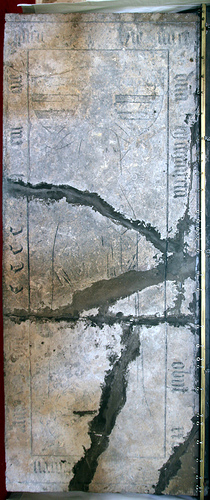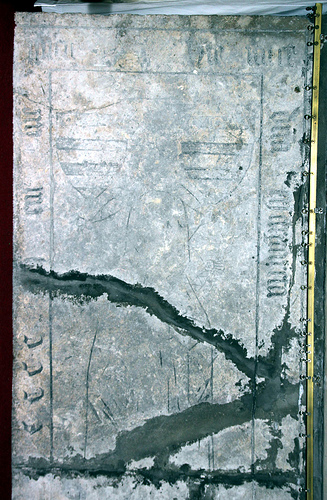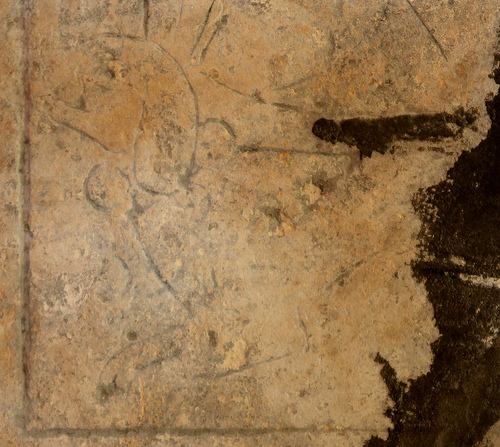Lady Margaret - errr who?

Incised slab - Torksey, Lincolnshire, originally uploaded by Vitrearum (Allan Barton).
After saying mass on the altar at Torksey, I removed the frontal to take some photos of the fascinating object it covers. The front of the stone altar at Torksey is formed from a fifteenth century incised slab. The centre of the slab has a full length, but very worn, figure of a woman. She wears a long gown, her fully covered head resting on a tasselled pillow, a little lap dog playing at her feet. The marginal inscription around her is fairly generic 'Hic jacet Domina Margareta' it says 'Here lies Lady Margaret'. The slab is very broken and sadly the bit of slab that gave her surname is badly damaged, but you can work out that her name ended in 'on'. She died sometime in the fifteenth century, but once again the bit that was engraved with the year has been broken. On either side she has two shields of arms, 'barry of six', but in the absence of tinctures, they are frustratingly of little use. So Lady Margaret the anonymous. 
It has been suggested that the figure was that of the last prioress of the Priory of Fosse, a poor Cistercian priory within the parish of Torksey. Given that the priory was dissolved in 1539 and the slab is fifteenth century, that seems unlikely. Various suggestions have been made to complete the name of the 'prioress', including Margaret Winton and Margaret Multon. However, neither name accords with any in the list of prioresses in the Victoria County History. The only Margaret who served in that office was Margaret Barnby elected in 1410 and as the surname of this mysterious Lady Margaret ends in 'on' this is a blind alley too. So for the moment she remains unidentified. 
Personally I am not convinced she is a prioress at all. I would expect her ecclesiastical position to be noted in the inscription and it is not. Also the little lap dog at her feet is perhaps indicative that she is in fact a lay woman, I can't imagine a prioress of a poor and austere Cistercian house (and in 1539 it was described as a 'beggarly poor house') is likely to have owned or asked to be portrayed with such a luxury on her grave slab.
For some reason F A Greenhill, the slab historian, managed to miss this slab in his 'Monumental Incised Slabs in the County of Lincolnshire' even though he recorded another inscription in the church. I suppose the location of the slab doesn't help! Anyway an interesting puzzle, one that I am determined to work at. My next stop is a search of Lincoln Wills to see if any match up.
- Fourth-century Hebrew Inscription Discovered In Portugal
Archaeologists of the Friedrich-Schiller-University Jena found one of the oldest archaeological evidence so far of Jewish Culture on the Iberian Peninsula at an excavation site in the south of Portugal, close to the city of Silves (Algarve). On a marble...
- Medieval Burial Stone Stolen From Herefordshire Church
Part of a Medieval burial stone has been stolen from a Herefordshire church. The 8.5cm (3.3in) thick child's burial slab, was stolen from St Mary's Church in Foy, near Ross-on-Wye. Church Warden Andrew Netting said the stone, measuring 51cm (20in)...
- Crusader Inscription By Frederick Ii Discovered In Israel
An Arabic inscription that bears the name of the Holy Roman Emperor, Frederick II, and the date ?1229 of the Incarnation of our Lord Jesus the Messiah?, was recently deciphered by Professor Moshe Sharon and Ami Shrager of the Hebrew University of Jerusalem....
- Memorial Altarpiece
The parish church of Youlgreave in the Derbyshire peak district, has a rather remarkable and interesting medieval alabaster panel. This rectangular panel is currently set into the wall above the altar at the east end of the north nave aisle, though it...
- 'who Caused This Church To Be Built'
Bag Enderby, Lincolnshire, originally uploaded by Vitrearum.The atmospheric littlee church in the hamlet of Bag Enderby in the Lincolnshire wolds is a Perpendicular building built from beginning to end in one campaign. A simple brass inscription set...
